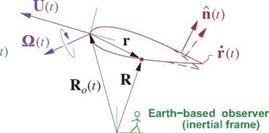Unsteady Panel Method
Standard panel methods which solve the steady potential flow problem can be extended to the unsteady case. The source+doublet panel method will be used here to illustrate these necessary modifications.
3.1.3 Sources of unsteadiness
 |
Figure 7.5 shows the possible origins of flow unsteadiness in an aerodynamic flow which must be captured by any general unsteady flow solution method. These are further described below.
Body motion
One possible source of unsteadiness is unsteady rigid-body motion. This is defined by the specified velocity and rotation rate U(t) and Q(t) introduced in the body-point velocity definition (7.11).
Gust field
Unsteady flow can also be caused by a nonuniform atmospheric motion or “gust” velocity field Vgust(R, t) which is specified. The instantaneous Earth position of any body point r on the aircraft is
R(r, t) = Ro(t) + r
where Ro is obtained by integrating U in time, as described in Chapter 9. The gust velocity at the body point r is then
VgUSt(r, t) = VgUSt(R(r, t),t)
where Earth/body axis conversions using the body Euler angles would be used, as described in Section 9.4. These are obtained by integration of the aircraft rotation rate O(t). In reality, any such gust field will be modified by the presence of the body, but for the typical gust field which has long variations relative to the body size this effect will be small and is generally neglected. This is consistent with classical thin airfoil approximations.
Body deformation
The third cause of flow unsteadiness is a time-dependent body geometry with local velocity r, such as an oscillating flap or a flapping wing. If the deformation of the motion is small, its effects can be approximated by holding the geometry fixed, but still using the actual surface velocity r and normal vectors П when forming the flow-tangency condition.











